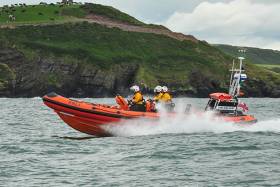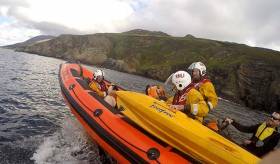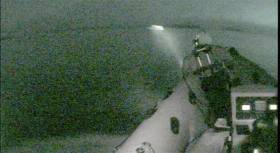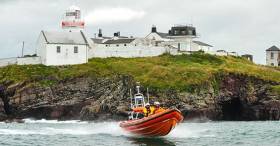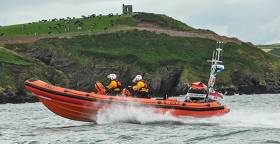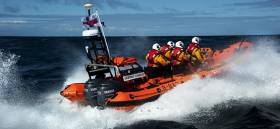Displaying items by tag: Lifeboat
Crosshaven RNLI Lifeboat Assist Anglers After Breakdown
Crosshaven RNLI Lifeboat in Cork Harbour was requested to launch yesterday evening at 9.45pm to reports of a speedboat broken down and adrift approximately one km south west of Trabolgan.
In calm conditions with a slight sea,the volunteer crew, under the command of Alan Venner with Ian Venner, Aoife Dinan and Vince Fleming on board headed to the area at best speed.
On arrival, the two anglers onboard the vessel had attempted remedial work with no results. The crew of the lifeboat then established a tow and landed the casualty at Crosshaven boatyard.
The lifeboat returned to station at 11.30pm and is currently being washed down and refuelled by the shore crew before being declared ready for service.
Six Rescued in Two Separate Call Outs for Clifden RNLI
Clifden RNLI rescued six people in two separate call outs off the Connemara coast last week.
On Friday afternoon, the volunteer lifeboat crew was requested to launch their all-weather and inshore Atlantic 85 class lifeboats following a report that two people were in the water after their 6ft boat had ran aground and hit rocks.
The lifeboat helmed by Joe Acton and with crew members Dermott Clancy, Alvin Bell and Kenneth Flaherty onboard, launched within minutes and made its way to the scene on the south east side of Davillaun.
With a report that two people had entered the water, the Irish Coast Guard’s helicopter Rescue 118 from Sligo was also tasked and a pan-pan was put out to all vessels in the area to assist in the operation.
Weather conditions at the time were described as dry but blowing a Force 5-6 gale with a choppy sea and a good ground swell.
Clifden’s inshore lifeboat was the first vessel to arrive on scene where the crew observed that the two men had managed to get themselves on the rocks. They were cold and wet and holding on to their boat to keep it afloat.
Lifeboat crew member Alvin Bell was put onto the rocks where he assessed the casualties and ensured they were ok. With no injuries sustained he then proceeded to help them on to the lifeboat where they were further assessed and made comfortable. A towline was then set up and the casualty vessel was pulled off the rocks and brought alongside the lifeboat to prevent further damage.
Following an hour long tow, the two men and their vessel were brought safely back into Derryinver Pier.
Earlier in the week, the lifeboat was called upon on to assist the crew of a 35ft trawler that had got into difficulty on Clifden Bay.
The Atlantic 85 inshore lifeboat was requested to launch at 11.30am on Tuesday (23 August) after gear got tangled in the prop of the trawler resulting in no steerage and no propulsion.
The lifeboat helmed by Joe Acton and with crew members Alvin Bell, Kenneth Flaherty and Eoin Hayes onboard, made its way to scene where they worked with the four crew onboard to set up a towline.
Weather conditions were good with a flat calm sea. However, with the boat running against the tide, helm Joe Acton called on the assistance of Clifden’s D class inshore lifeboat which on arrival helped with the safe manoeuvre of the trawler into the quay at Clifden.
Speaking following the two call outs, Clifden RNLI helm Joe Acton said: ‘We were happy to be of assistance on both occasions last week. Friday’s call out was a bit more challenging following the initial report that two people were in the water but thankfully they had managed to make it on to rocks where they were waiting safe and well if not cold and wet following their ordeal.
‘We would encourage anyone taking to the sea for work or pleasure, to enjoy it but to always respect the water. Always wear a lifejacket and carry a means of calling and signalling for help. Always check the weather forecast and tide times. Make sure someone ashore knows where you are going and who to call if you don’t return on time. Learn how to start, run and maintain your engine before taking to the water.’
Lough Swilly RNLI lifeboat rescued a sheep this afternoon after it fell approximately 200 feet from a cliff in County Donegal.
The alarm was raised at 4.30pm today when three local fishermen spotted the animal stranded on a ledge in a ravine at Leenan Head with no means of escape.
The fishermen contacted Malin Head Coast Guard and Lough Swilly’s inshore Atlantic 85 lifeboat was requested to launch.
Weather conditions at the time were described as good with a flat calm sea.
Once on scene, the volunteer lifeboat crew were met by the fishermen who pointed to where the distressed sheep was located. A kayaker who had also arrived on scene, first paddled in close to the cliff in an attempt to encourage the animal back up the hill.
With this failing to work, the lifeboat crew and the kayaker proceeded to enter the water and make their way towards the sheep where they safely caught her and gently placed her in the kayak before transferring her into the lifeboat.
Once onboard the lifeboat, the sheep was comforted by the crew and safely brought back to more familiar surroundings on shore.
Speaking following the call out, Joe Joyce, Lough Swilly RNLI Volunteer Lifeboat Press Officer said: ‘We think the young sheep had fallen about 200 feet and with nowhere to go she was shaking from her ordeal by the time we took her onboard the lifeboat. The RNLI is often called upon to rescue animals and we are always happy to assist not only to bring them to safety but also to ensure the safety of pet owners or farmers who may risk their own life in attempting to bring their animal safely back to shore.’
Early Morning Calls Lead To Lifeboat Launch on Lough Derg
Lough Derg RNLI Lifeboat launched at 5.20am, following reports to Gardaí of calls for help coming in off the lake.
At 05.06am this morning, Lough Derg RNLI Lifeboat was requested to launch by Valentia Coast Guard, following a report to Nenagh Gardaí of calls for help heard coming in off the lake, that woke sailors camping at Lough Derg Yacht Club.
As volunteer crew assembled, they were informed by Gardaí, who were at the Lifeboat Station, that a cruiser was seen to leave the public harbour close to the time the calls for help were heard.
The lifeboat launched at 05.18am with helm Eleanor Hooker, Ger Egan and Owen Cavanagh on board. Winds were light, southeasterly. Visibility was poor with fog and just before dawn.
The Irish Coast Guard Search and Rescue Helicopter team based at Shannon, were on standby should they be required.
The lifeboat set a route south, in the direction from which the calls were heard, and using a search light quickly located a cruiser at anchor close to the navigation channel, south of the Corrakeen Islands, outside Dromineer Bay.
The lifeboat crew roused the passengers on board and made them check that everyone was accounted for on board. The passengers said they may have been making some noise as they left the harbour earlier, and would be continuing their passage south at daybreak.
The lifeboat reported their findings to Valentia Coast Guard and, advised that the cruiser’s companion boat was moored in Dromineer Harbour, would check that they had no difficulties.
Once it was established neither vessel was missing a passenger, the lifeboat returned to station.
Brian Hanley, Deputy Launching Authority at Lough Derg RNLI Lifeboat, advises boat users to ‘respect the water, enjoy the lake, but ensure one person remains fully in command of your boat at all times’.
The lifeboat returned to Station and was ready for service again at 06.10am
Lough Derg RNLI Lifeboat Assist Nine on Cruiser With Engine Failure
At 3.30pm yesterday, Lough Derg RNLI Lifeboat was requested to launch by Valentia Coast Guard, following a report from people on shore at Mountshannon, that people were seen waving a distress signal on a cruiser outside the bay. The lifeboat launched at 3.45pm with helm Eleanor Hooker, Peter Clarke and Owen Cavanagh on board. Winds was westerly, Force 5/6 gusting 7. Visibility was good.
Nine people were on board, three adults and six children.
The lifeboat located the vessel in Mountshannon Bay at 4pm. All nine people on board were safe and unharmed and wearing their lifejackets. They had dropped anchor to prevent being pushed onto nearby rocks. An RNLI volunteer lifeboat crew was transferred to the casualty vessel where he reassured everyone, and then set up a bridle and tow. The lifeboat took the tow and went ahead of the cruiser to assist the RNLI volunteer weigh anchor, which had dug in and was holding fast.
The lifeboat towed the cruiser to Mountshannon Harbour where she was tied safely alongside at 4.30pm. The Lifeboat returned to station and was ready for service again at 5pm.
Pat Lynch, Deputy Launching Authority at Lough Derg RNLI Lifeboat advises boat users to ‘to check weather forecast before going afloat, make sure your boat is serviced and to carry a means of communication’.
Crosshaven RNLI Lifeboat crew responded to a request from Valentia Coast Guard this evening to a person seen being held onto the side of a moored boat in the Channel at East Ferry.
The Crosshaven volunteer crew happened to be near Roches Point on exercise when the emergency call came through and immediately made best speed to the area arriving some 15 minutes later at 20.45. The crew located the casualty and recovered him to the lifeboat.
It appears the sailor had the mishap while transferring to a punt. The other person required no assistance.
With obvious signs of hypothermia and limb injuries after spending 20/25 minutes in the water, the lifeboat crew administered First Aid and headed for Cobh and a rendevous with the Emergency Ambulance. The casualty was handed into the care of the paramedics before returning to station at 21.50.
Courtmacsherry RNLI Lifeboat Rescues Jet Skiers & Pleasure Craft
The Courtmacsherry RNLI All Weather Lifeboat was called out at 5.15 pm yesterday afternoon to go to the aid of three men who got into difficulty in a Jet–ski and small pleasure boat just off the Seven Heads coastline in West Cork.
The Courtmacsherry Lifeboat under Coxswain Sean O'Farrell and a crew of six launched immediately and reached the area at 5.25pm as the three men had overturned in their crafts and were in the water.
The casualties were blown on to dangerous rocks at Seven Heads and the Courtmacsherry Lifeboat succeeded in taking all three men from the rocks and onboard the Lifeboat.
The Coastguard unit from Seven Heads, the Coastguard Rescue Helicopter and The Kinsale RNLI Lifeboat all participated in today's rescue
Crosshaven RNLI Launch to Supermarket Dinghy Blown Out to Sea
Crosshaven lifeboat was launched this afternoon after a member of the public alerted the Coast Guard to an inflatable Dinghy with thre persons on board being blown out to sea.
The lifeboat launched at 14.52 and made their way to Ringabella Bay arriving on scene at 3.10pm. No sighting of the dinghy initially was made, but the crew noticed a Supermarket type inflatable dinghy on the shore at Ringabella beach. A crew member swam ashore and talked to the owners who confirmed they were the 3 people that had left Fountainstown. As they were now ashore and safe all units were stood down.
The occupants were wearing swim gear apart from one who had a wetsuit and a bouyancy aid. The wind offshore was blowing force 5 to 6 although calmer within the bay. Crosshaven Coast Guard imparted safety information to the people involved.
Commenting on the service call, Patsy Fegan, Lifeboat Operations manager said "The use of inflatables and lilo's should only be used in the confines of a swimming pool. Luckily these people came to no harm, but with a force 5 wind they could have drifted well offshore”
As well as Crosshaven Lifeboat, other agencies involved were Rescue 117 helicopter from Waterford, The Naval vessel, LE Niamh which acted as a Radio Relay to the Coast Guard and the Crosshaven Coast Guard boat.
The RNLI beach lifeguard unit on Benone Strand on the North coast has been vandalised for a second time this season.
A member of the public reported that at approximately 10pm on Monday night last (1 August), they spotted damage being caused to the beach lifeguard unit near the entrance to the beach.
On further investigation, the charity’s lifeguards discovered on Tuesday morning that the vandals had damaged the roof of the beach lifeguard unit having stripped off the brackets that secure an essential VHF aerial.
Ideal for the harsh beach environment, lifeguards rely on handheld VHF radios to communicate with each other when on patrol and to communicate with their colleagues in the Coastguard in the event of an emergency.
RNLI Lifeguard Supervisor Karl O’Neill said: ‘While we were fortunate to find the wire wasn’t damaged on the aerial which would have rendered our VHF communications off service, the damage was such that given the poor weather we have been experiencing the signal could have been affected.’
Prior to the peak season commencing this summer, a window door entrance was smashed in the hut during the Easter period.
It is estimated that the repairs to the beach lifeguard unit will run into hundreds of pounds for the charity.
The RNLI is working closely with the Police Service of Northern Ireland in an attempt to prevent further damage being done to the beach unit for the remainder of the season.
‘We would appeal to those doing this damage to be mindful that the RNLI is a charity’, Karl continued. ‘Our lifeguards are an essential part of what is a seamless rescue service that saves lives from the beach to the open sea. Our lifeguards’ primary role on Benone Strand as on all eight lifeguarded beaches on the Causeway Coast is to make sure the beach can be enjoyed safely by the public.
‘We hope that these acts of vandalism will cease and that our lifeguards can continue to operate from the unit safely.’
Red Bay RNLI Rescues Man After Fall From Wall in Cushendall
Lifeboat crew from Red Bay RNLI rescued a man who fell over a wall sustaining multiple injuries in the early hours of this morning (Sunday 31 July).
The man who fell at 2.30am landed close to rocks beside the lifeboat station in Cushendall. A community action plan was quickly was put into action and the lifeboat crew was paged to provide first aid.
Crew members along with an off-duty paramedic were quickly on scene where they assessed the casualty who had suffered a broken thigh.
Using the station’s first aid pack complete with oxygen and Entonox, the lifeboat crew worked with the paramedic in challenging conditions to stabilise the man and stretcher him to the lifeboat station in an operation lasting over an hour.
The man was later transferred by ambulance to the Causeway Hospital in Coleraine.
Speaking following the incident, Paddy McLaughlin, Red Bay RNLI Volunteer Lifeboat Press Officer said: ‘The man was very unfortunate to fall where he did last night and we would like to wish him a speedy recovery from his ordeal.
‘This was a great example of a community working well together to come to someone’s aid. Many will associate Red Bay RNLI with the water but this incident proved how having people with the right skills and training with the essential first aid equipment including oxygen and Entonox, can rescue someone in need.
This was the second incident that Red Bay RNLI responded to this weekend. On Saturday evening just before 6pm, the lifeboat crew was requested to launch their inshore lifeboat after a member of the public spotted two canoeists who they thought to be in trouble in the Murlough Bay area near Fair Head which is known to be dangerous.
Arriving on scene, the lifeboat crew checked the canoeists were safe and well before allowing them to continue unaided.


























